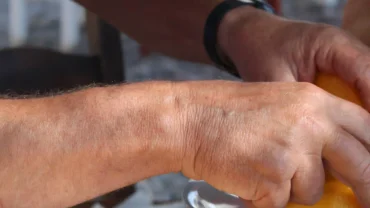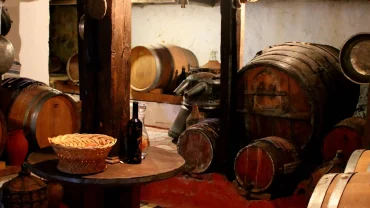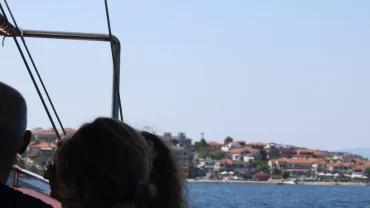The fun and spree of the Kastorian carnival is now known to everyone The Ragoutsaria, as the carnivals are called, are celebrated from the 6th to the 8th of January and are a revival of the ancient Dionysian ceremonies, which took place from ancient times and according to the locals is a celebration that aims to forget the problems of the year.
Carnival events are the culmination of the holidays for the city, because they are combined with the holidays of the twelve days in Ragoutsaria everyone takes part, Kastorians and visitors and pours into the streets and alleys of the city with reference point Mitropoleos Street and Omonia Square, celebrating with dances, songs, teasing and plenty of wine In Ragoutsaria take part many orchestras with brass instruments, coming from the surrounding areas of Macedonia but also Balkan countries such as Serbia, Bulgaria and Skopje, consisting of 5 to 12 people If you are in Kastoria during the events you will feel what a spree it will say and surely the whole process will not leave you indifferent
The origin of the name:
The name Ragoutsaria comes from the Latin rogatores, meaning beggars (still rogatio in Latin means ask), since the disguised ask the housewives, whose houses they visit, to give them gifts in order to ward off evil spirits.
History:
The Ragoutsaria originate from the ancient Winter Dionysians, and are known by this name only in Macedonia and Thessaly, where there was a troupe of disguises that went from house to house, entering and greeting the housewives asking for treats and tips. They were hidden behind sheepskins and makeshift masks, taking care to remove the evil spirits that plagued the world of those times. During Roman rule, disguises continued and new festivities were added. The Rogatores (beggars), during their visit to the houses of the area, received treats and tips, expelling the evil spirits that made life difficult for people In Byzantine times, the worship festivals of Ancient Greece came into conflict with the official Christian Religion and many elements were lost or completely forgotten. However, many of them managed and withstood the time and obstacles, reaching to the present day During the Turkish occupation, they managed to cross the threshold of the 20th century as “cursed ragoutsarides” (those painted black on the face and body). The residents took to the streets in disguise, visiting houses, mainly of the celebrants, and necessarily arrived at the square in Dolcho. Teasing, gratuities and treats were essential throughout the scene Until the decade 1920-1930, the presence of Bacchus was necessary with the accompaniment of a donkey adorned with vine leaves and supported on his saddle the steak of the god Dionysus, in which there was a small barrel of wine. During the 1940s-50s and the return of many Kastorians from abroad, new changes in disguise began to appear. The big and well-known cafes “Aigli” and “Byzantio” organized all-night parties, with groups of disguised people, some of whom were disguised according to the traditional customs, while others began to adopt new ways and models of disguise. In the middle of the decade, the awarding of the disguised by the Municipality of Kastoria began, giving another dimension to the whole process.
Disguises:
In ancient times, people disguised themselves as animals, such as cows, deer, and goats. During the Byzantine period, this disguise was strictly forbidden, and so other forms of disguise were gradually introduced, such as e.g. gender reassignment (men wear skirts and scarves and women mustaches and ties), a typical Ragoutsari costume was to simply put their jacket upside down .. However, until 1930 in Ragoutsaria the figure of Bacchus dominated. In addition to the symbolic interpretations of the custom, the Kastorian Ragoutsaria today give a cheerful and fun note, attracting many visitors for a frantic party beyond the usual.
Ragoutsaria today:
The beginning of the carnival takes place on the Epiphany, after the throwing of the cross and the sanctification of the waters. Focusing on Mitropoleos Street and Omonia Square, the disguised people come and go dancing and having fun. On the second day, on the day of Ai Gianni, each group goes home (as has been the case for a long time), to ward off evil spirits and to encourage housewives to participate in the frantic feast. On the third day, the events culminate with the big parade (crutch) of the chariots and the disguises (buns and school groups), starting from the City Hall, reaching Omonia Square, after passing Mitropoleos Street and ending at Dolcho Square. During the parade, which lasts several hours, schools and groups take part in the parade on foot and with the accompaniment of instruments. Then the best entries in the various categories (appearance, spectacle, satire, tradition) are awarded with the delivery of souvenirs. In the heart of winter and during the last hours of the twelve days, the city of Kastoria surrenders to a unique three-day feast of joy and spree, which is spontaneously born in the countless groups of young and old who take part. On the three days of January 6, 7 and 8, the halls and nightclubs are full of people, having fun and having fun, taking care to maintain the customs and traditions of the area.
Source: ragoutsariakastorias.gr




Comment (0)